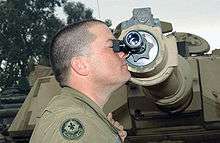Boresight (firearm)


Boresight is a method of adjustment to an optical firearm sight or iron sights, to align the firearm barrel and sights. This method is usually used to pre-align the sights, which makes zeroing (zero drop at XX distance) much faster. A device called a bore sighter or collimator is used to accomplish this.[1] It consists of an optical head and a bore-diameter arbor which is inserted into the muzzle of the rifle. The optical head is then attached to the protruding end of the rod. A grid pattern on the optical head is then used to align the sights with the barrel.[2]
Traditional boresighting, as the name suggests, involves removing the bolt and sighting down the bore of a gun to a fixed point. While the rifle is fixed in place, the scope or irons can then be adjusted to also aim at the distant object. A more modern method of boresighting is to use a laser rather than by visual inspection to illuminate the distant point. This method is preferable because it allows more movement in the gun, as the laser dot will not move relative to the barrel, and is a method of boresighting which does not require the removal of the bolt.
A more advanced method of boresighting uses a collimator, an optical attachment similar to a scope sight, which fits onto the end of the barrel. Using this method, the normal sight (which is fixed to the receiver) and the collimator (which is fixed to the barrel) can be sighted to match. Most collimators have grid patterns for rechecking the zero after the barrel is sighted.
As laser technology has become less expensive, laser bore sighters have become popular for sighting in rifles. One type of laser bore sight is inserted into the chamber and projects a beam through the barrel onto the target. The user then adjusts the rifle scope until the crosshairs are on the laser dot. Another type of laser bore sighter is more universal and is attached to the end of the barrel. It is held in alignment with the barrel and projects a laser beam onto the target. Again, the user aligns the crosshairs to the laser dot on the target.
A Laser Analyzing Autocollimator (LAA) device, that was recently developed by Duma Optronics, allows boresighting between multiple lines of sights to a laser source. The set-up of the LAA performs an alignment of lasers to their mechanical axis or external sights without the need for an external target, while achieving high accuracy and reliability in this process.
No matter which method of bore sighting is used, the result is to align the cross-hairs of the scope to the spot where the barrel is pointing at a particular distance. Because of variations in the trajectory of ammunition and other factors the bore-sighted rifle will probably not shoot to the exact spot that the cross-hairs indicate, and live ammunition will need to be fired to fine-tune the sighting process.
Accuracy is the measure of how well the sighted object is represented. It can be measured from a specific decision-making circumstance, like the orientation of notches of a gun barrel. Alternatively the device could be designed to accommodate a range of circumstances and still be sufficiently accurate.
References
- ↑ Field & Stream - Google Books. Retrieved 2012-04-07.
- ↑ Popular Science - Google Books. Retrieved 2012-04-07.
<http://www.duma.co.il/electronic-autocollimator.html> <http://www.novuslight.com/autocollimator-laser-and-bore-sighting_N2822.html>